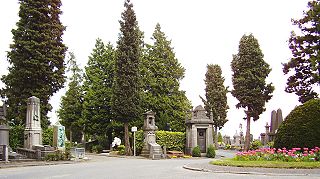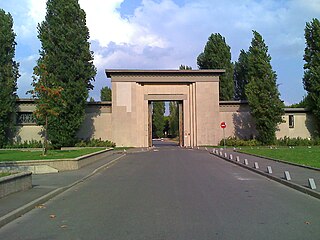
Jacques-Louis David was a French painter in the Neoclassical style, considered to be the preeminent painter of the era. In the 1780s, his cerebral brand of history painting marked a change in taste away from Rococo frivolity toward classical austerity and severity and heightened feeling, harmonizing with the moral climate of the final years of the Ancien Régime.
The Cemetery of Montmartre is a cemetery in the 18th arrondissement of Paris, France, that dates to the early 19th century. Officially known as the Cimetière du Nord, it is the third largest necropolis in Paris, after the Père Lachaise Cemetery and the Montparnasse Cemetery.

Passy Cemetery is a small cemetery in Passy, in the 16th arrondissement of Paris, France.

Laeken or Laken is a residential suburb in the north-western part of the Brussels-Capital Region, Belgium. It belongs to the municipality of the City of Brussels and is mostly identified by the Belgian postal code: 1020. Prior to 1921, it was a separate municipality.

François Rude was a French sculptor, best known for the Departure of the Volunteers, also known as La Marseillaise on the Arc de Triomphe in Paris. (1835–36). His work often expressed patriotic themes, as well as the transition from neo-classicism to romanticism.

Olšany Cemeteries is the largest graveyard in Prague, Czech Republic, once laid out for as many as two million burials. The graveyard is particularly noted for its many remarkable art nouveau monuments.

Brussels Cemetery is a cemetery belonging to the City of Brussels in Brussels, Belgium. Located in the neighbouring municipality of Evere, rather than in the City of Brussels proper, it is adjacent to Schaerbeek Cemetery and Evere Cemetery, but should not be confused with either.

Ixelles Cemetery, located in Ixelles in the southern part of Brussels, is one of the major cemeteries in Belgium. Ixelles Cemetery also refers to a neighbourhood with a lot of bars and restaurants for students, north of the actual cemetery. It is in fact located between the two main campuses of the Université libre de Bruxelles (ULB).

Uccle or Ukkel is one of the 19 municipalities of the Brussels-Capital Region, Belgium. In common with all of Brussels' municipalities, it is legally bilingual (French–Dutch). It is generally considered an affluent area of the city and is particularly noted for its community of French immigrants.

Pierre-Jean David was a French sculptor, medalist and active freemason. He adopted the name David d'Angers, following his entry into the studio of the painter Jacques-Louis David in 1809 as a way of both expressing his patrimony and distinguishing himself from the master painter.

Antoine Joseph Wiertz was a Belgian painter, sculptor, lithographer and art writer. He is known for his religious, historical, and allegorical works and portraits. He was an eccentric figure who originally was much influenced by the works of Rubens and Michelangelo. Some of his works are erotic and macabre and presage Belgian Symbolism. While snubbed by contemporary art critics, he enjoyed the support of the new Belgian state, which in return for his paintings assisted him in building his personal studio/home in Brussels, where the artist worked on his art and writings as a recluse.

The Death of Marat is a 1793 painting by Jacques-Louis David depicting the artist's friend and murdered French revolutionary leader, Jean-Paul Marat. One of the most famous images from the era of the French Revolution, David painted it when he was the leading French Neoclassical painter, a Montagnard, and a member of the revolutionary Committee of General Security. Created in the months after Marat's death, the painting shows Marat lying dead in his bath after his murder by Charlotte Corday on 13 July 1793. Art historian T. J. Clark called David's painting the first modernist work for "the way it took the stuff of politics as its material, and did not transmute it".

Mount Jerome Cemetery & Crematorium is situated in Harold's Cross on the south side of Dublin, Ireland. Since its foundation in 1836, it has witnessed over 300,000 burials. Originally an exclusively Protestant cemetery, Roman Catholics have also been buried there since the 1920s.

Marie Alexandre Lenoir was a French archaeologist. Self-taught, he devoted himself to saving France's historic monuments, sculptures and tombs from the ravages of the French Revolution, notably those of Saint-Denis and Sainte-Geneviève.

Montparnasse Cemetery is a cemetery in the Montparnasse quarter of Paris, in the city's 14th arrondissement. The cemetery is roughly 47 acres and is the second largest cemetery in Paris. The cemetery has over 35,000 graves and approximately a thousand people are buried here each year.

Schaerbeek Cemetery, officially Schaerbeek New Cemetery, is a cemetery belonging to Schaerbeek in Brussels, Belgium, where the municipality's inhabitants have the right to be buried. It is not located in Schaerbeek itself; rather it is partially in the neighbouring municipality of Evere, and partially in the village of Sint-Stevens-Woluwe in Zaventem, Flemish Brabant. The cemetery is adjacent to Brussels Cemetery and Evere Cemetery, but should not be confused with either.

The cimetière parisien de Thiais is one of three Parisian cemeteries extra muros, and is located in the commune of Thiais, in the Val-de-Marne department, in the Île-de-France region.

Édouard De Bièfve was a Belgian history and portrait painter. He was one of the leading representatives of the romantic movement in Belgium and his work had an important influence on the development of history painting in Germany.

Charlotte David or Marguerite-Charlotte Pécoul (1764–1826) was the French wife of the painter Jacques-Louis David.

Louis Emmanuel Aimé Damesme was an architect famous for designing the Royal Theatre of la Monnaie and the House of the renowned French painter, Jacques-Louis David, in Brussels. He was born in Magny-en-Vexin on 19 April 1757 and died in Paris on 14 April 1822. Damesme was head of the architectural studio of Claude-Nicolas Ledoux.




















